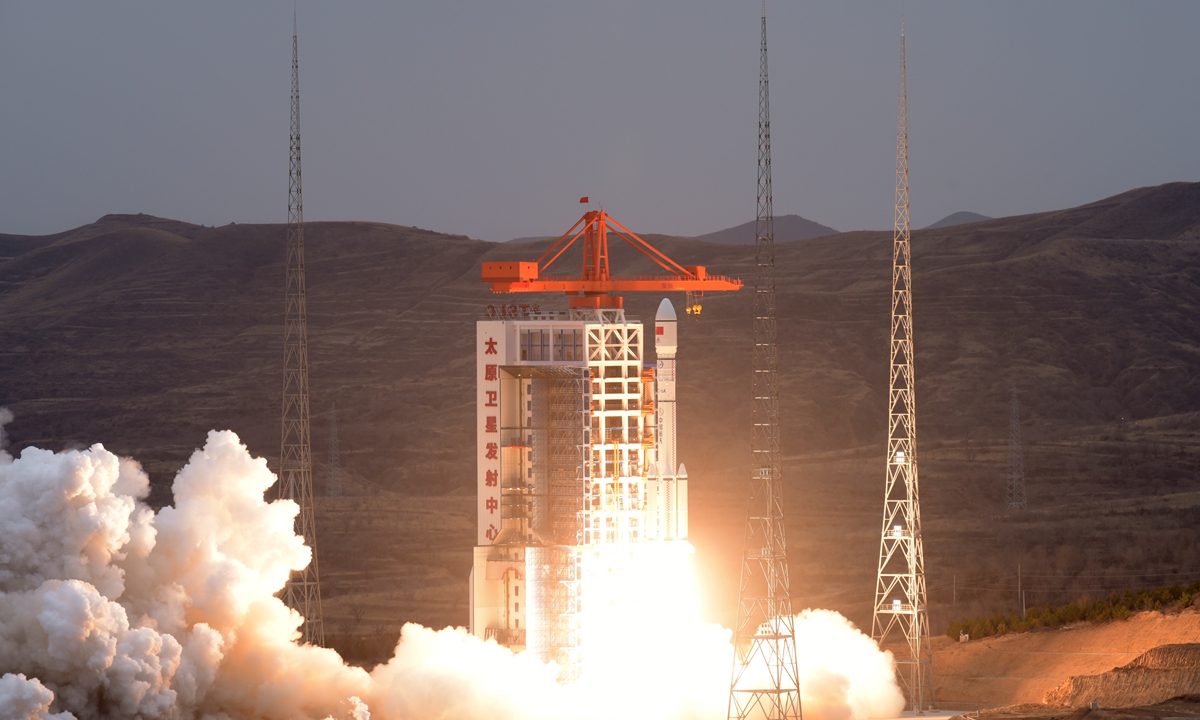Long March-6A, China's new-generation medium-sized launch vehicle, conducted a successful maiden flight at 5:50 pm on Tuesday from Taiyuan Satellite Launch Center in North China's Shanxi Province, sending two satellites into preset orbits.
The rocket is developed by the Shanghai Academy of Space Technology (SAST), a subordinate of the state-owned China Aerospace Science and Technology Corporation (CASC). The successful launch marked the first victory of SAST new rocket type development in the 14th Five-Year Plan (2021-25). Developers said the news was a confidence boost as Shanghai is struggling with a COVID-19 flare-up.
At launch, the rocket has a weight of 530 tons and is capable of sending payload of no less than 4 tons to the Sun-synchronous orbit. The new member of the Long March carrier rocket family is 50 meters in height and has two 3.35-meter-diameter stages with the first adopting a 120-ton-thrust liquid oxygen/kerosene engine and a 18-ton-thurst one for the second, said a statement the SAST provided to the Global Times on Tuesday.

A Long March-6A carrier rocket takes off from the Taiyuan Satellite Launch Center for its maiden flight on March 29, 2022. Photo: Sun Gongming
Marking a design breakthrough in the country's aerospace history, the new rocket has four 2-meter-diamter solid-propellant boosters attached to its body, developers said. The boosters also have two stages and have a thrust of 120 tons, which are developed by the Fourth Academy of the CASC.
It is the first rocket type that has realized a cooperation of liquid and solid engines in China, clearing key technical barriers such as the solid boosters attachment and detachment technology, developers said.
Such a hybrid-propellant technology would fully utilize the advantages of the two systems - the liquid engine has long working hours with high performance while the solid one has more powerful thrust and better reliability and is easy to maintain. The birth of the Long March-6A would further enrich the type of spectrum of China's rockets, enhancing China's capability in space exploration, analysts pointed out.
Adopting a similar technological path, the US Atlas 5, Europe's Ariane 5 and H-2A of Japan have performed several successful flights. However, it was a first for a Chinese rocket in active service to perform a flight with solid boosters, developers added.
The Long March-6A could also enable rapid launches with preparations of only 14 days thanks to the newly built launch site at the Taiyuan Center, which will meet the highly frequent launch requirement to the medium and low orbit satellites, insiders said.
According to the developers, the Long March-6A also adopted a range of new technologies used at launch such as the "unattended operation" that started four hours before the blast-off, enhancing safety.
To make the "unattended operation" a reality, the rocket must perform an automatic docking and fueling via remote control, the rocket ground connector should also automatically fall off at the moment of take-off and once the propellant injection starts, it requires no personnel to watch over at the launch pad, which all marked firsts in China.
Hong Gang, the rocket type's commander-in-chief, told the Global Times on Tuesday that as the rocket is developed in a path of modularization, combination and modularization, it could also come in different variants according to the mission demand such as ones without boosters or other forms with two boosters.
The Tuesday flight marked the 412nd mission of China's Long March rocket family.
The rocket sent Tiankun-2 and Pujiang-2 satellites into their designated orbits on Tuesday.
Tiankun-2 is a new technology experiment satellite developed by the Second Academy of China Aerospace Science and Industry Corporation (CASIC), and its developers told the Global Times on Tuesday that it could provide a range of services such as space science exploration.
Inheriting the high functional density of Tiankun-1, the first experimental satellite independently developed by CASIC, which was sent into orbit in March 2017, Tiankun-2 has lower manufacturing costs and is smaller in size.
The Tiankun-2 is tasked with verifying key technologies such as new attitude and orbit control algorithms, multi-functional flexible cladding materials, and computational optical imaging, satellite developers revealed.




